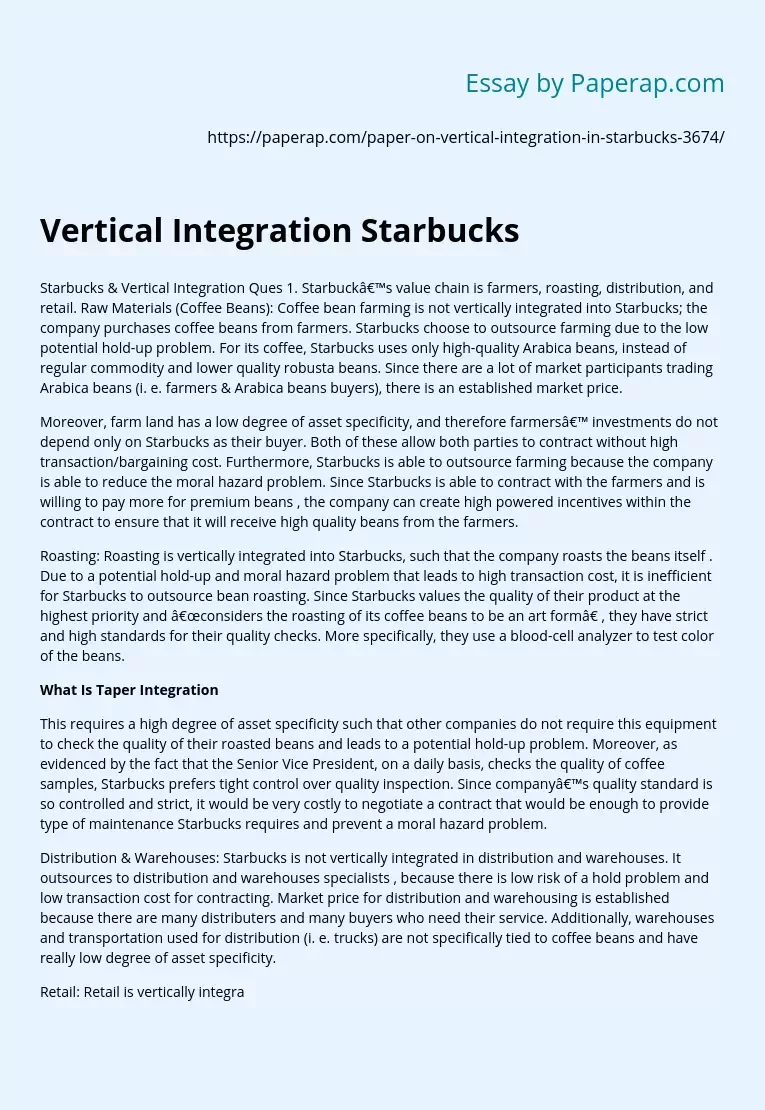Vertical Integration Starbucks
Starbucks & Vertical Integration Ques 1. Starbuck’s value chain is farmers, roasting, distribution, and retail. Raw Materials (Coffee Beans): Coffee bean farming is not vertically integrated into Starbucks; the company purchases coffee beans from farmers. Starbucks choose to outsource farming due to the low potential hold-up problem. For its coffee, Starbucks uses only high-quality Arabica beans, instead of regular commodity and lower quality robusta beans. Since there are a lot of market participants trading Arabica beans (i. e. farmers & Arabica beans buyers), there is an established market price.
Moreover, farm land has a low degree of asset specificity, and therefore farmers’ investments do not depend only on Starbucks as their buyer. Both of these allow both parties to contract without high transaction/bargaining cost. Furthermore, Starbucks is able to outsource farming because the company is able to reduce the moral hazard problem. Since Starbucks is able to contract with the farmers and is willing to pay more for premium beans , the company can create high powered incentives within the contract to ensure that it will receive high quality beans from the farmers.
Roasting: Roasting is vertically integrated into Starbucks, such that the company roasts the beans itself . Due to a potential hold-up and moral hazard problem that leads to high transaction cost, it is inefficient for Starbucks to outsource bean roasting. Since Starbucks values the quality of their product at the highest priority and “considers the roasting of its coffee beans to be an art form” , they have strict and high standards for their quality checks.
More specifically, they use a blood-cell analyzer to test color of the beans.
What Is Taper Integration
This requires a high degree of asset specificity such that other companies do not require this equipment to check the quality of their roasted beans and leads to a potential hold-up problem. Moreover, as evidenced by the fact that the Senior Vice President, on a daily basis, checks the quality of coffee samples, Starbucks prefers tight control over quality inspection. Since company’s quality standard is so controlled and strict, it would be very costly to negotiate a contract that would be enough to provide type of maintenance Starbucks requires and prevent a moral hazard problem.
Distribution & Warehouses: Starbucks is not vertically integrated in distribution and warehouses. It outsources to distribution and warehouses specialists , because there is low risk of a hold problem and low transaction cost for contracting. Market price for distribution and warehousing is established because there are many distributers and many buyers who need their service. Additionally, warehouses and transportation used for distribution (i. e. trucks) are not specifically tied to coffee beans and have really low degree of asset specificity.
Retail: Retail is vertically integrated into Starbucks. Instead of franchising, it has company-owned stores. Starbuck choose to vertically integrate due to its main strategy of selling a unique “Starbucks experience. ” More specifically, Starbucks stores aim to create a “consistent, inviting, stimulating environment that evoked the romance of coffee, that signaled the company’s passion for coffee, and that rewarded customers with ceremony, stories, and surprise. For this strategy to be successful, the company needs to “replicate precisely” this experience in all of its stores. But the amount of control required to maintain this much consistency is too costly to negotiate in order to create a contract, and therefore inefficient to outsource. Ques 2. Roasting: The integration of roasting is a source of competitive advantage because this capability is both valuable and rare. Starbucks’ full control of the roasting process allows the company to ensure that the beans are roasted at a high quality.
Consequently, Starbucks is able to offer a product that satisfies the demand for premium coffee. Moreover, the resulting difference in quality between Starbucks’ coffee and their competitors’ allows Starbucks to differentiate itself and gain market share. Retail: The integration of retail is also a source of competitive advantage because this capability is also valuable and rare. Through Starbuck’s full control and consistent management of the distinctive Starbucks experience, the company is able to create a strong brand equity.
Establishing a strong brand equity allows the company maintain market presence. Additionally, considering that there are many coffee producers competing against Starbucks, having a strong brand equity allows the company to differentiate themselves. Ques. 3 Roasting: The integration of roasting is only a temporary competitive advantage for the Starbucks because this capability is imitable. Although Starbucks has its own method of roasting and a high quality inspection process, there is no evidence that the process is a protected secret.
Hence, competitors are able to copy the process as long as they have the financial resource, equipment, trained employees. However, if the roasting and inspection process is indeed a protected secret, then integration of roasting is a sustainable competitive advantage. As a protected secret, competitors will not be able to imitate it. Furthermore, this capability is firm specific to Starbucks considering that the company has been roasting their own coffee beans since the beginning. Retail: The integration of roasting is a sustained competitive advantage for the Starbucks.
Through full control of retail and consistent management of the distinct “Starbucks experience” over time, Starbucks has created a strong brand equity that can be sustained. The Starbucks brand is now synonymous with premium coffee. However, if Starbucks fails to maintain consistency in the management of its retail and “Starbucks experience,” opportunities will become available for competitors to produce similar retail experiences to Starbucks and steal market share. Bibliography 1. ) Starbucks Coffee Company, Tuck School of Business at Dartmouth, p. -9, http://mba. tuck. dartmouth. edu/pdf/2002-1-0023. pdf 2. ) Starbucks Corporation, the McGraw-Hill Companies, http://www. mhhe. com/business/management/thompson/11e/case/starbucks-2. html 3. ) Starbucks Corporation: Competing in a Global Market, UW Business School, p. 3, http://bschool. washington. edu/gbc/documents/starbucks_final. pdf 4. )Starbucks Coffee Company, p. 15. 5. )Starbucks Corporation, http://www. mhhe. com/business/management/thompson/11e/case/starbucks-2. html 6. ) Ibid.
Vertical Integration Starbucks. (2019, Dec 05). Retrieved from https://paperap.com/paper-on-vertical-integration-in-starbucks-3674/

